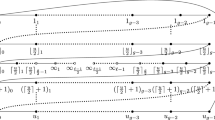Abstract
Shrinking technology and growing complexity of the contemporary system on chip designs require high performance and reliable interconnection architecture. Binary CDMA on-chip bus permits simultaneous use of the shared communication medium by multiple data streams and alleviates contention and queuing delays experienced by a conventional time-division multiplexing shared bus. In this paper, we present an encoding scheme for improving reliability of the on-chip interconnect system based on a binary CDMA bus. Without adding extra wires to the bus, the proposed encoding method replaces the standard binary encoding with a non-weighted code which tolerates single-bit error at any bus wire within the timing window of a single CDMA transaction. In addition, we derive constraints for a codeword selection under which the single-bit error tolerance is achieved and provide a recursive algorithm for code construction. Simulation results show that the proposed encoding scheme significantly improves the post-decoding bit error rate performance of the binary CDMA bus under a binary symmetric channel model.







Similar content being viewed by others
References
Chiang MC, Sohi GS (1992) Evaluating design choices for shared Bus multiprocessors in a throughput-oriented environment. IEEE Trans Comput 41(3):297–317. doi:10.1109/12.127442
Kim J, Lai BC, Chang M-CF, Verbauwhede I (2008) A cost-effective latency-aware memory bus for symmetric multiprocessor systems. IEEE Trans Comput 57(12):1714–1719. doi:10.1109/TC.2008.96
Kim J, Verbauwhede I, Chang M-CF (2007) Design of an interconnect architecture and signaling technology for parallelism in communication. IEEE Trans Very Large Scale Integr Syst 15(8):881–894. doi:10.1109/TVLSI.2007.900739
Chang M-CF, Verbauwhede I, Chien C, Xu Z (2005) Advanced RF/baseband interconnect schemes for inter- and intra-ULSI communications. IEEE Trans Electron Devices 52(7):1271–1285. doi:10.1109/TED.2005.850699
Pasricha S, Dutt N (2008) On-chip communication architectures: system on chip interconnect. Elsevier, Morgan Kauffman, Amsterdam
Wani MA, Arabnia HR (2003) Parallel edge-region-based segmentation algorithm targeted at reconfigurable multi-ring network. J Supercomput 25(1):43–63. doi:10.1023/A:1022804606389
Bhandarkar SM, Arabnia HR (1995) The hough transform on a reconfigurable multi-ring network. J Parallel Distrib Comput 24(1):107–114. doi:10.1006/jpdc.1995.1011
Arabnia HR, Bhandarkar SM (1996) Parallel stereocorrelation on a reconfigurable multi-ring network. J Supercomput 10(3):243–270. doi:10.1007/BF00130109
Raghunathan V, Srivastava MB, Gupta RK (2003) A survey of techniques for energy efficient on chip communication. In: Proceedings design automation conference, pp 900–905. doi:10.1109/DAC.2003.1219148
Halak B, Ma T, Wei X (2014) A dynamic CDMA network for multicore systems. Microelectron J 45(4):424–434. doi:10.1016/j.mejo.2014.02.002
Kim M, Kim D, Sobelman GE (2005) Adaptive scheduling for CDMA-based networks-on-chip. In: The 3rd international IEEE-NEWCAS conference, pp 357–360. doi:10.1109/NEWCAS.2005.1496682
Wang X, Ahonen T, Nurmi J (2007) Applying CDMA technique to network-on-chip. IEEE Trans Very Large Scale Integr Syst 15(10):1091–1100. doi:10.1109/TVLSI.2007.903914
Bell Jr RH, Chang KY, John L, Swartzlander Jr EE (2001) CDMA as a multiprocessor interconnect strategy. In: Conference record of 35th asilomar conference on signals, systems and computers, vol 2, pp 1246-1250. doi:10.1109/ACSSC.2001.987690
Karmarkar K, Tragoudas S (2014) Error correction encoding for tightly coupled on-chip buses. IEEE Trans Very Large Scale Integr Syst 22(12):2571–2584. doi:10.1109/TVLSI.2014.2300095
Lehtonen T, Wolpert D, Liljeberg P, Plosila J (2010) Self-adaptive system for addressing permanent errors in on-chip interconnects. IEEE Trans Very Large Scale Integr Syst 18(4):527–540. doi:10.1109/TVLSI.2009.2013711
Sridhara SR, Shanbhag NR (2005) Coding for system-on-chip networks: a unified framework. IEEE Trans Very Large Scale Integr Syst 13(6):655–667. doi:10.1109/TVLSI.2005.848816
Karmarkar K, Tragoudas S (2014) On-chip codeword generation to cope with crosstalk. IEEE Trans Comput-Aided Des Integr Circuits Syst 33(2):237–250. doi:10.1109/TCAD.2013.2284017
Ganguly A, Pande PP, Belzer B (2009) Crosstalk-aware channel coding schemes for energy efficient and reliable NoC interconnects. IEEE Trans Very Large Scale Integr Syst 17(11):1626–1639. doi:10.1109/TVLSI.2008.2005722
Chang KC (2011) Reliable network-on-chip design for multi-core system-on-chip. J Supercomput 55:86–102. doi:10.1007/s11227-009-0376-4
Egwutuoha IP, Levy D, Selic B, Chen S (2013) A survey of fault tolerance mechanisms and checkpoint/restart implementations for high performance computing systems. J Supercomput 65:1302–1326. doi:10.1007/s11227-013-0884-0
Namazi A, Nourani M, Saquib M (2010) A fault-tolerant interconnect mechanism for NMR nanoarchitectures. IEEE Trans Very Large Scale Integr Syst 18(10):1433–1446. doi:10.1109/TVLSI.2009.2024779
Nikolic T, Nikolic G, Stojcev M, Stamenkovic Z (2015) Low-power fault-tolerant interconnect method based on LCDMA and duplication. Microelectron Reliab 55(1):272–281. doi:10.1016/j.microrel.2014.09.029
Golubov B, Efimov A, Skvortsov V (1991) Walsh series and transforms: theory and applications. Kluwer, Springer, The Netherlands
Chan AM, Feldman J, Madyastha R, Indyk P (2006) Low-complexity localized walsh decoding for CDMA systems. IEEE Mil Commun Conf MILCOM. doi:10.1109/MILCOM.2006.302017
Wicker S (1995) Error control systems for digital communication and storage. Prentice Hall, Englewood Cliffs
Acknowledgments
This work was supported by the Serbian Ministry of Education, Science and Technological Development, Project No. TR-32009—“Low-Power Reconfigurable Fault-Tolerant Platforms”.
Author information
Authors and Affiliations
Corresponding author
Rights and permissions
About this article
Cite this article
Nikolic, T.R., Nikolic, G.S., Djordjevic, G.L. et al. Improving fault-tolerance capability of on-chip binary CDMA bus. J Supercomput 72, 275–294 (2016). https://doi.org/10.1007/s11227-015-1513-x
Published:
Issue Date:
DOI: https://doi.org/10.1007/s11227-015-1513-x




